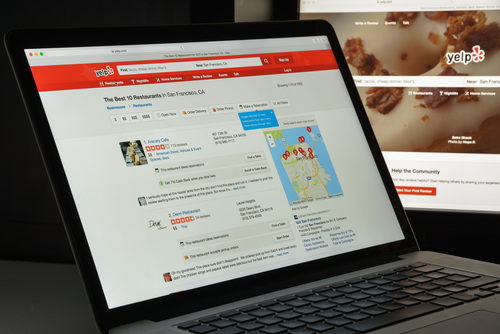EDUCATION
Protecting Your Brand’s Online Reputation
Proactively Monitoring Your Brand’s Online Profile Is an Essential E-Marketing Strategy
By Douglas McColloch

component of online brand promotion, it’s more important than
ever to be proactive in patrolling the Internet for online reviews,
then devising a strategy to encourage positive feedback while
dealing with negative reviews in a professional and respectful
way. Photo courtesy: Shutterstock.com
With digital and social-media campaigns becoming an ever-more-
important component to marketing portfolios, a company’s online reputation can make or break the business. A particular challenge in this sphere is that people are more motivated to post online reviews when they’ve had an unpleasant experience with a company than when they’re happy with their experience. For businesses of all kinds, the question becomes: How do we respond when we receive negative feedback? Can we possibly turn a critic into a champion for our brand? How can we garner more positive reviews while mitigating the effects of negative ones?
A recent SEMA360 presentation, “How to Protect Your Brand’s Online Reputation,” examined the subject in some detail. Hosted by best-selling author and social-media specialist Corey Perlman, the webinar aimed to provide SEMA-member companies with some useful tips focused not only on managing a brand’s online reputation but also boosting it.
First, though, we need to understand why this is such an important part of any company’s marketing strategy.
Why it Matters
There are a number of reasons why taking an active role in managing your brand’s online reputation is so important.
Nearly half of all Google searches are for local businesses. While Google has a global reach, most consumers begin their online searches by looking for businesses and companies in their own communities. “Google is the behemoth in the search-engine space,” Perlman noted, “but local searches still dominate.”
More than 90% of searchers will pick a business from the first page they view. Since Google uses overall activity as a metric in its ranking system, it’s important that a company’s online presence engages consumers and encourages repeat visits. “We need to make sure we are focused on the first page of that Google search, because most people don’t click to the next page,” Perlman said.
More than 90% of consumers say that online reviews influence their purchasing decisions. Most crucially, more than 90% of consumers say that an online review has convinced them to avoid a business or product. If consumers are leaving negative reviews about your company online, it can affect your bottom line in ways that aren’t noticeable on the surface.
Perlman puts it this is way: “We never hear from the people who don’t buy from us. We never get a call where someone says, ‘Hey, I was going to purchase your product, but I read a review online or I went to your Facebook page and there was nothing to look at, and I decided to go with someone else.’ That’s why it’s important to make sure you are proactively increasing your odds that people are having a positive experience when they are checking you out online.”
Seven of out 10 people will leave an online review if they are asked. “People are more motivated when they’re unhappy than when they’re happy,” Perlman observed. “If I’ve had an unpleasant experience online, you don’t need to motivate me to talk about it online. That’s just the world we live in. Our job as a business is to create a process to ensure that all satisfied customers are talking about their experiences with us online.”

simple searches. Look for mentions of your company on
Google, Facebook, Instagram and other social-media sites.
Make sure that your company’s online presence engages
users and is regularly being updated. Photo courtesy:
Shutterstock
Protecting Your Castle
Perlman likes to draw an analogy to a medieval castle surrounded by a moat.
“That castle is your business, and the moat is the positive energy you are generating online with good reviews. Beyond the moat are the attackers—the negative reviews that are attacking our castle. Every time we get more positivity online, we’ve expanded the moat and made it more difficult for people to attack us for whatever reason, and so everything that we’re doing to proactively get positive reviews is simply creating a larger moat around our castle.”
Perlman recommended the following steps to expand your company’s moat.
Perform a digital audit. Step number one, Perlman said, is “Google yourself and see what shows up. Go beyond the first page and look at all the different places where your brand is being talked about online. You may find social-media profiles that you may or may not know about. Maybe you had an intern come in a few years ago and create a Snapchat or a LinkedIn company page that’s never been managed, or you may have a Facebook or Instagram account that you haven’t been managing or isn’t being updated regularly. You never know what you’re going to find.
“The point is, what you’ll find is typical of what prospects may be finding when they’re checking you out and determining whether or not to do business with you. Look through the lens or the perspective of a potential buyer and see what they see, and if you see issues, you need to fix them.”
As a rule, the most glaring issues confronting a company online stem from a lack of engagement or attentiveness. “It could be a lack of content or lack of use on a social-media site, a lack of positive reviews, and just places that you’re not currently managing,” Perlman said. “Also, are you responding to reviews and comments? You might find a Yelp directory with positive responses, but you didn’t take the time to say ‘thank you.’ Since you’re the business owner, claim ownership of that directory and then respond to those reviews. Let people know that you really appreciate the kind words.”
Match your company’s online brand with its offline brand. This can be a challenge, but it’s one that companies need to address to maintain a stellar online reputation.
Perlman explained: “When I walk the halls of the SEMA Show, I see that your ‘offline’ brand has no issue. You have the most brilliant, beautiful products that I’ve ever seen. The question is, does your online brand match that of your offline brand? If you’re in the business of creating specialty products, I know that you put exceptional care into the quality of those products. Are you making sure that same care is demonstrated on the platforms you’re represented on online?
“Do you have a consistent professional brand online? If I go to your Facebook page, will I be impressed? If I go to your website, will I be impressed? If I go to your Instagram or Snapchat, will I be impressed? Will I look at that and say, ‘Wow, these guys really know what they’re doing. They create beautiful work!’”
At this point, a company looking to optimize its online brand reputation will work to ensure that there are no holes in its game when it comes to its different digital assets. Those are going to include its social-media profiles, its website and those directories.
“If I go to your Google My Business page, why should it not have similar branding to that of your Facebook or Instagram to the extent that you can?” Perlman asked. “So make sure that you have someone within your team who can implement a consistent, professional-quality look and feel across all of your digital assets.”
Plan for the worst. This step involves anticipating negative feedback online and creating a process for responding to it in a way that will be most beneficial to your brand’s reputation.
“We don’t need to motivate people to post about us when they’re unhappy,” Perlman said. “With the work that you put into the products and the services that you provide, it absolutely guts you when somebody is unhappy, for whatever reason, but it’s a reality in the digital world that we live in, so we’ve got to have a plan.”
Successfully handling and responding to negative reviews starts with some commonsense pointers.
Be diplomatic. “Never ever try to argue with a reviewer,” Perlman explained. “It rarely helps the business. When you argue with the reviewer or with the customer, it just looks bad. It may look bad for them, but it definitely looks bad for you.”
If time permits, sleep on it. “Never respond out of emotion. Always take a moment, sleep on it, and respond when you’re ready to be diplomatic, you’ve taken the emotion out of it, and you want to try to solve the problem.”
Be empathetic. “Try to fix the problem. Whether or not you agree with the reviewer, try to fix it. I have seen instances where a one-star review gets posted, the owner responds to the problem, the problem gets fixed, and the reviewer comes back later and edits the review.”
People love to see that kind of authenticity and transparency from businesses when companies reach out to dissatisfied customers, Perlman noted.
“Your overall trust and credibility is actually higher when they see businesses and businesspeople working hard to try to solve their customers’ issues—and we all know that issues are going to come up.”
If you can’t solve the problem online, take the discussion offline. “Be empathetic and try to solve the problem. If you can’t for some reason, tell the customer, ‘Hey, I’m really sorry we haven’t been able to get a resolution. Give me your phone number or email address. I’m going to call you. We’ll try to figure this out.”

influential in affecting consumer attitudes about a company. To
succeed on such sites, companies need to be proactive in
engaging user responses, working to solve problems as they
rise, and expressing gratitude to users for positive reviews.
Photo credit: Shutterstock
Monitoring Your Web Cred
For those with limited time and resources to devote to online reputation management, there are a number of web-based tools such as Social Mention and Google Alerts to help them with the task. “Set up a Google Alert for your brand, and if any pages show up that are indexed by Google that have your brand on it, Google will send you an alert to it,” Perlman explained. “So if a blog post comes up, for example, and they are describing their experience with your product or service, you’ll be notified.”
For monitoring social media, Buffer and Hootsuite perform similar functions, allowing companies to easily apply hashtags and then receive notification whenever the hashtag is posted elsewhere. “If somebody takes a picture of one of your awesome products and posts it on Instagram with your hashtag, you’ll see the product post if you follow that hashtag—even if they’re not connected with you.”
Generating Positive Buzz
To Perlman, the most essential part of an online brand reputation is “creating a process for generating positive feedback.”
“I always tell my fellow business owners to stop worrying so much about negative reviews and start worrying more about losing the people who love them but who aren’t posting online,” he said. “Don’t worry so much about the one potential negative review that might come in the next 10 years. What about the hundred positive sentiments that you could have online if you just had a process for them?”
Steps that companies can take to encourage positive feedback include:
Talk to your team about listening for clues. “When and where do positive moments in the workplace happen?” Perlman asked. “For example, if you’re a service shop of some kind, it might be the installers or it might be the technicians. They might be the ones who are around when somebody walks in and says, ‘Oh, my gosh, you killed it, man. Thank you so much.’ That’s the moment when they can pull out a card for the customer to fill out and say, “Hey, it makes my day to hear that, and if you wouldn’t mind sharing your experience, it would mean the world to us.”
Instruct the customer on what to do and where to go. “A lot of people don’t exactly know where to go to review you. So give them the link, or send them an email with the link embedded in it. If it’s a Facebook review or if it’s an Instagram post or a Twitter post, tell the customer exactly where to go, what tag to use, and how you’d like the customer to say it.”
It’s okay to incentivize. If your business model permits it, “it’s really up to you whether or not you feel comfortable offering some sort of discount or additional service or something similar for a review.”
Most importantly, show your appreciation. Be sure to express your appreciation to your customers for taking the time to respond online. That could take the form of “a $5 Starbucks card that you send out maybe via email with a message saying, ‘Thank you for doing business with us. We know that it takes time and energy to write a review, so coffee’s on us today,’” Perlman suggested. “That’s one way of doing it, but what works best is what works for your business.”
Finally, under best practices, train your team to tell your customers, “The best way to thank us is to post about us.”
“Never let a verbal testimonial go unpublished,” Perlman concluded. “What I mean by that is when somebody verbally says good things about you, whether it’s in person or via email or text, always respond with, ‘Thank you, and would you mind posting it online for us?’ That’s going to help tremendously.”
 About SEMA Education
About SEMA Education
Accessing SEMA’s industry-leading education is easier than ever. With dozens of live and on-demand offerings—and more debuting during the year—SEMA Virtual Education includes comprehensive presentations, insightful discussions, and short videos that teach, inform, inspire and entertain automotive specialty-equipment professionals. From builders and engineers to marketers and sales staff and more, participants will become more educated and prepared for success. To learn more, visit www.sema.org/virtual-education.
 About Corey Perlman
About Corey Perlman
Bestselling author, public speaker and social-media specialist Corey Perlman is the owner of Impact Social Inc., advising companies large and small about digital marketing strategies. He started his career with the eCommerce Division of General Motors before launching his consulting and speaking business in 2009. Since then, he’s worked with such notable brands as Sysco Foods, The American Healthcare Association, Dale Carnegie Training and the PGA Tour. He can be reached by visiting www.impactsocialmedia.com and
www.coreyperlman.com.





